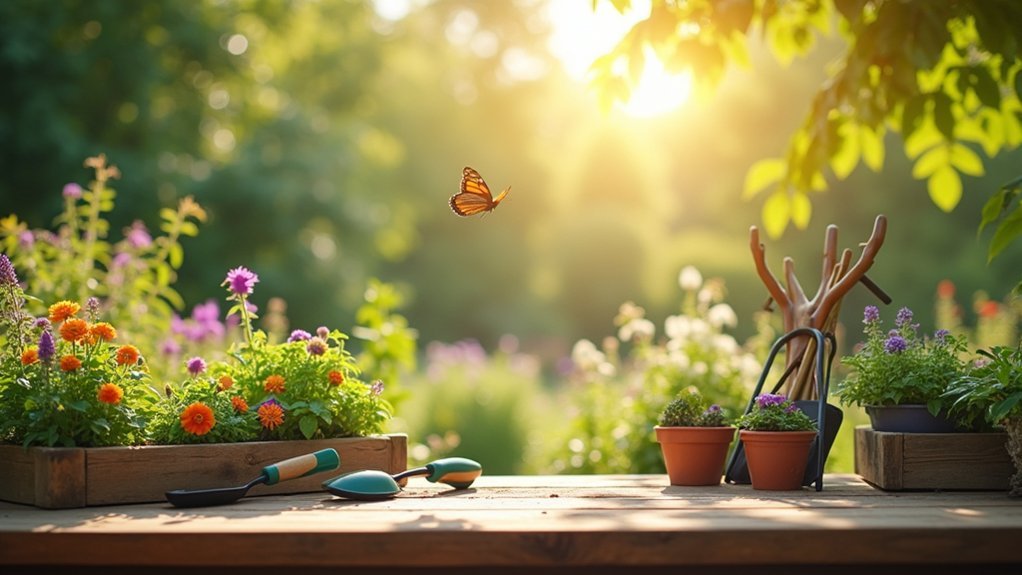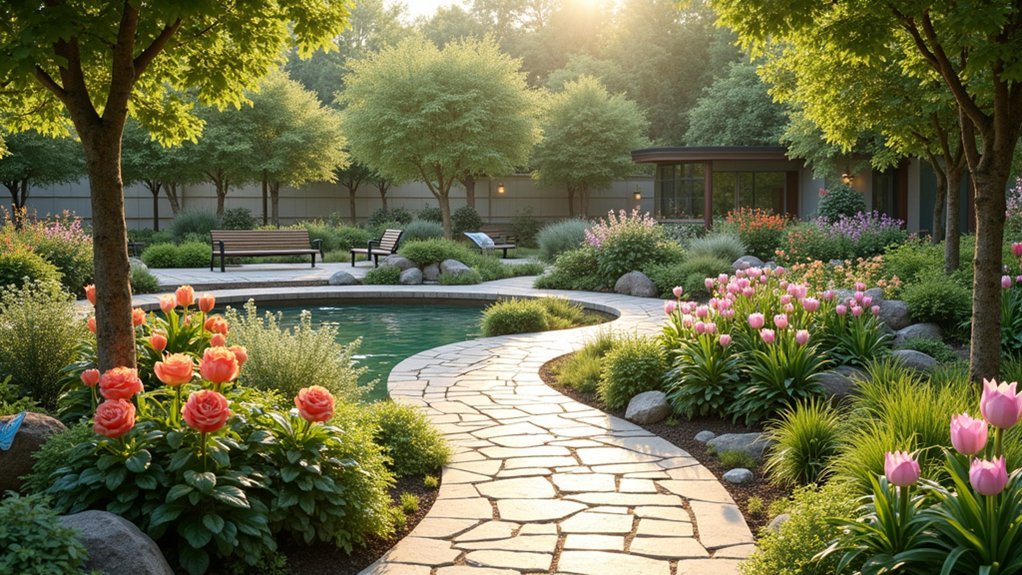For effective rehabilitation therapy gardens, prioritize accessibility with wide, smooth pathways and raised beds that accommodate mobility challenges. Select plants that engage multiple senses—fragrant lavender, touchable lamb’s ear, and visually stimulating marigolds create therapeutic experiences. Adapt gardening tools with ergonomic grips and extended reaches to promote independent participation. These thoughtful design elements transform outdoor spaces into powerful healing environments where patients can regain confidence and strength through meaningful connection with nature.
Designing Accessible Garden Spaces for Mobility Challenges

When creating healing gardens for rehabilitation therapy, accessibility must be your foundation rather than an afterthought.
Design paths at least five feet wide with firm, smooth surfaces to accommodate wheelchairs and walkers, ensuring everyone can connect with nature safely.
Nature’s embrace should welcome everyone—wide, smooth paths create the bridge between healing gardens and those who need them most.
Incorporate raised beds and vertical gardening options throughout your therapeutic gardens to minimize bending and reaching.
This thoughtful garden design enables participants with limited mobility to engage in gardening activities comfortably.
Don’t forget to provide ample seating areas where visitors can rest while enjoying the therapeutic benefits of the environment.
Select lightweight, ergonomic gardening tools with extended handles to reduce strain during sessions.
Your healing gardens should feature intuitive layouts with clear pathways and minimal obstacles, empowering those with mobility challenges to navigate independently.
Selecting Therapeutic Plants for Sensory Stimulation
While designing your healing garden layout, choosing the right plants becomes essential for creating meaningful sensory experiences. Incorporate fragrant lavender for aromatherapy and vibrant marigolds for visual stimulation in your therapeutic plants selection.
Don’t overlook tactile plants like lamb’s ear and fuzzy kalanchoe that invite touch exploration—particularly beneficial in rehabilitation centers. Include edible herbs such as mint and rosemary to engage taste senses and encourage patient participation in gardening activities.
For auditory stimulation, integrate sound-producing plants like bamboo or ornamental grasses that create gentle rustling sounds in breeze.
Always select non-toxic varieties appropriate for your region’s hardiness zone to guarantee safety and minimize maintenance demands. This sensory-rich plant combination will support diverse therapeutic goals while offering year-round healing garden benefits.
Adapting Gardening Tools for Independent Participation

Because healing gardens serve therapeutic purposes, adapting gardening tools becomes essential for enabling all participants to engage regardless of physical limitations.
In horticultural therapy settings, specialized equipment transforms gardening from a challenging task into an accessible form of therapeutic recreation.
- Ergonomic gardening tools reduce body strain, making them perfect for those recovering from injuries—their lightweight design allows for extended use without fatigue.
- Adaptive equipment like forearm cuffs secures tool grips, enhancing independent participation.
- Extended-reach tools such as watering wands let you access plants without straining your back.
- Tool caddies attached to buckets facilitate organization and transport, making enabling gardens more accessible for those with mobility challenges.
You’ll find these adaptations create more inclusive healing gardens where everyone can participate autonomously.
Frequently Asked Questions
What Should Be in a Healing Garden?
Your healing garden should include diverse sensory plants, water features, comfortable seating areas, accessible paths for wheelchairs, and raised planter beds. You’ll create a space that engages all senses while ensuring everyone’s comfort.
How Do You Rehab a Garden?
You’ll need to assess your garden’s condition first, then repair hardscape elements. Add raised beds for accessibility, choose emotionally resonant plants, incorporate sensory elements, and regularly evaluate the space’s functionality for ongoing improvements.
What Are the Elements of a Therapeutic Garden?
You’ll want accessible pathways, raised beds, water features, sensory plants, and comfortable seating in your therapeutic garden. Don’t forget focal points like sculptures that encourage meditation and support emotional healing.
What Is the Healing Garden Theory?
The Healing Garden Theory explains how you’ll benefit from nature exposure during recovery. It’s based on evidence that you’ll experience reduced stress, improved mental health, and faster healing when you connect with plant-rich environments.
In Summary
You’ve now got practical tools to create a healing garden that supports rehabilitation therapy. By designing accessible spaces, you’ll guarantee everyone can navigate your garden regardless of mobility. When you select plants for sensory engagement, you’re building therapeutic opportunities. And with adapted gardening tools, you’ll empower independent participation. Your healing garden isn’t just beautiful—it’s a powerful space for recovery and growth.





Leave a Reply